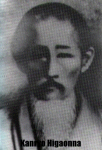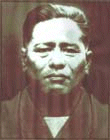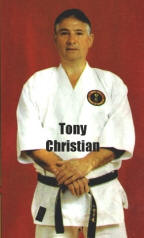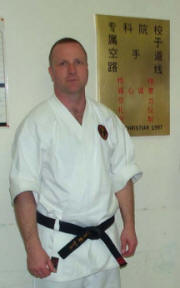History
Many Styles of Karate are practised in the U.K. today. However, the GoJu Ryu Academy of Karate-Do is Perhaps only one of a handful of clubs who that are able to trace their History and Family tree from it's foundation through to the current Sensei, Tony Christian and able to consider the influence each has had on the development of their style
|
GoJu Ryu Karate originated in Okinawa, the largest of a group of Islands between Japan, China and Taiwan. Okinawa had a fighting system that had developed from 1100 and became influenced by Chinese Kempo. The majority of GoJu Ryu Kata were first introduced by Kanro Higaonna (1853-1917), who had travelled to China in order to develop his own fighting style. It is believed that he was taught for several years by a man called Ryu Ryu Ko in Fuzhou province of South Eastern China. Sanchin which forms the basis of GoJu Ryu was introduced, along with Saifa, Sayunchin, Shisochin, Sepai, Sanseiru, Sesan, Kururunfa and Suparinpei. Little is known about Ryu Ryu Ko, who may Have been a Shaolin monk, or about the early history of the GoJu Ryu style before this time, such is the lack of documentation of events and the general secrecy with which the Chinese kept Karate training. The true age of these Kata is thus unknown. Some texts track their origens back to the 6th century from Shaolin temple boxing, others argue that exercises were introduced into the temples by Bhodhidarma, (who is also credited with introducing Buddhism and Zen from India), as a way of strengthening monks living in an impoverished lifestyle. |
|
|
Others say, that the styles originated in a Chinese society 2000 years earlier. Whatever story is believed it is likely that the development was part of the monastic disciplines of the temples. |
|
|
Okinawa's various self-defence disciplines continued to be fostered in secrecy up until around 1912. With increasing Japanese influence over the islands, they became less secretive, modernised and introduced into the school systems. It was Higaonna's successor Chojun Miyagi (1888-1953), who popularised the style practised today and it is he who is credited as being the founder of GoJu Ryu. Recognising that a formal title would be important in the popularity and development of Karate, Chojun Miyagi chose the name GoJu Ryu in 1930. The name derives itself from his favourite poem contained in the Bubishi, as reflecting the hard and soft techniques of his Karate with emphasis on correct breathing. Miyagi intended his Karate to influence an individual's physical and spiritual development and to increase the popularity of Karate amongst everyone, young, old, weak or strong. He also introduced the Kata Gekasai Dai Ichi and Gekasai Ni in 1940, as simpler forms of Kata that could be taught to children, together with Tensho for open hand practice, the Gekasai were also considered ideal for training Japanese Army conscripts who were noted to be less physical than their Okinawan counterparts. |
|
Following the War, the Americans in particular took interest in eastern fighting forms. A number of Miyagi's former students, including Teruo Chinen, took the style abroad following Miyagi's death in 1953. Mr Chinen remains faithful to the style of Miyagi and bases his own teachings upon the correct form of the Kata's. Tony Christian, was born in Liverpool and is now the principal teacher of GoJu Ryu in the United Kingdom. His early Karate was Wado Ryu. After being introduced to GoJu Ryu he Planned to visit Japan but ultimately sought out and became a student of Mr Chinen, with whom he trained in South Africa. Tony has since pursued his aim of making Karate practical in a modern day society, whilst remaining faithful to the early Okinawan masters of the art. His broad knowledge of other unarmed combat styles, together with an appreciation of modern and traditional Karate weapons is utilised to teach self-defence at his Academy. He also encourages his students to understand and question the meanings and applications of the Kata much more so than was passed down by his predecessors, rather than just expecting students to learn routines by rote. |
|
|
|
The Dojo Kun, adopted by Tony concentrates on the development of an individuals character in tandem with their Karate skills. This message is given particularly to children, who are taught Karate basics and kata rather than combat.Tony was recently awarded his 8th Dan by the B.K.A. Whilst Goju ryu's popularity may be tempered by its being a self-defence discipline, rather than a sporting or demonstration art form, his dojo boasts some 60 Dan grades and has already produced a number of satellite clubs affiliated to his own. This he hopes will ensure the quality, longevity and growth in the United Kingdom. Tony Bewley is one of Sensei Christians 6th Dan black belts and has been a student with Sensei Christian for over 30 years. Sensei Bewley holds the same principals of making Karate practical and effective in a modern society, coupled with the development of the character. |



